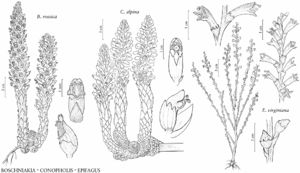Difference between revisions of "Conopholis alpina"
Förh. Skand. Naturf. Mötet 4: 184. 1847.
FNA>Volume Importer |
FNA>Volume Importer |
||
| Line 16: | Line 16: | ||
|name=Conopholis alpina var. mexicana | |name=Conopholis alpina var. mexicana | ||
|authority=(A. Gray ex S. Watson) R. R. Haynes | |authority=(A. Gray ex S. Watson) R. R. Haynes | ||
| − | }}{{Treatment/ID/Synonym | + | }} {{Treatment/ID/Synonym |
|name=C. mexicana | |name=C. mexicana | ||
|authority=A. Gray ex S. Watson | |authority=A. Gray ex S. Watson | ||
| Line 34: | Line 34: | ||
|elevation=1500–2800 m. | |elevation=1500–2800 m. | ||
|distribution=Ariz.;N.Mex.;Tex.;Mexico. | |distribution=Ariz.;N.Mex.;Tex.;Mexico. | ||
| − | |discussion=<p>R. R. Haynes (1971) recognized two varieties within Conopholis alpina based on purported differences in foliar texture, relative bract length, and glandularity, as well as semi-distinct ranges. However, the molecular and morphological analyses by A. G. Rodrigues et al. (2013) resulted in a reevaluation of taxon circumscriptions and redeterminations of selected specimens. The present treatment follows that of Rodrigues et al. in not recognizing infraspecific taxa within C. alpina.</p><!-- | + | |discussion=<p>R. R. Haynes (1971) recognized two varieties within <i>Conopholis alpina</i> based on purported differences in foliar texture, relative bract length, and glandularity, as well as semi-distinct ranges. However, the molecular and morphological analyses by A. G. Rodrigues et al. (2013) resulted in a reevaluation of taxon circumscriptions and redeterminations of selected specimens. The present treatment follows that of Rodrigues et al. in not recognizing infraspecific taxa within <i>C. alpina</i>.</p><!-- |
| − | --><p>B. R. McKinney and J. D. Villalobos (2014) documented the seeds of Conopholis alpina in the diet of Mexican black bears. The foraging behavior of bears in the western United States has given rise to one of the vernacular names, bear corn.</p> | + | --><p>B. R. McKinney and J. D. Villalobos (2014) documented the seeds of <i>Conopholis alpina</i> in the diet of Mexican black bears. The foraging behavior of bears in the western United States has given rise to one of the vernacular names, bear corn.</p> |
|tables= | |tables= | ||
|references= | |references= | ||
| Line 59: | Line 59: | ||
|publication year=1847 | |publication year=1847 | ||
|special status=Selected by author to be illustrated | |special status=Selected by author to be illustrated | ||
| − | |source xml=https://jpend@bitbucket.org/aafc-mbb/fna-data-curation.git/src/ | + | |source xml=https://jpend@bitbucket.org/aafc-mbb/fna-data-curation.git/src/8f726806613d60c220dc4493de13607dd3150896/coarse_grained_fna_xml/V17/V17_792.xml |
|genus=Conopholis | |genus=Conopholis | ||
|species=Conopholis alpina | |species=Conopholis alpina | ||
Revision as of 15:03, 18 September 2019
Stems 11–33 cm. Leaves triangular to narrowly lanceolate, 12–22 × 3–9 mm, mostly glandular-pubescent. Bracts mostly not concealing calyces, narrowly lanceolate, 12–22 × 2–7 mm, margins entire, glandular-ciliate, glandular-pubescent, veins not evident. Pedicels 0–3(–4) mm; bracteoles 0–2. Flowers: calyx 6–9 mm, lobe apex obtuse; corolla 14–20 mm; anthers sparsely pilose or glabrous. Capsules 8–15 × 6–12 mm; styles mostly deciduous.
Phenology: Flowering Feb–Jul.
Habitat: Oak woodlands, mixed montane forests.
Elevation: 1500–2800 m.
Distribution
Ariz., N.Mex., Tex., Mexico.
Discussion
R. R. Haynes (1971) recognized two varieties within Conopholis alpina based on purported differences in foliar texture, relative bract length, and glandularity, as well as semi-distinct ranges. However, the molecular and morphological analyses by A. G. Rodrigues et al. (2013) resulted in a reevaluation of taxon circumscriptions and redeterminations of selected specimens. The present treatment follows that of Rodrigues et al. in not recognizing infraspecific taxa within C. alpina.
B. R. McKinney and J. D. Villalobos (2014) documented the seeds of Conopholis alpina in the diet of Mexican black bears. The foraging behavior of bears in the western United States has given rise to one of the vernacular names, bear corn.
Selected References
None.
